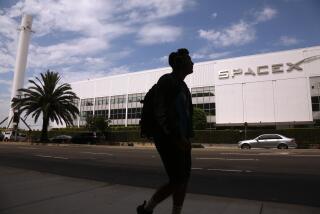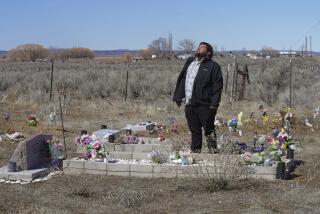Rocketdyne Suit Strategy Detailed
- Share via
Bringing tales of pain and hopes for compensation, neighbors of Rocketdyne’s Santa Susana Field Lab crowded into a Simi Valley meeting room Thursday to learn about a class-action suit against the firm’s parent company.
A team of lawyers explained to the crowd how they hoped to prove that decades of rocket testing and nuclear research at the 2,668-acre complex had poisoned the property and caused cancer in people living in the nearby Simi and San Fernando valleys.
Ten Rocketdyne neighbors sued parent company Boeing North American Inc. in U. S. District Court in Los Angeles on March 10, demanding that Boeing pay damages and set up a medical fund for future treatment of the cancer that they say was caused by work at the Rocketdyne lab.
But the group of potential plaintiffs has grown to nearly 100, and a court hearing tentatively scheduled for August will determine whether they can file as a group or must pursue their suits individually.
Attorney Barry Capello, who as Santa Barbara city attorney helped win a $10-million settlement against four major oil companies in the devastating 1969 Santa Barbara Channel spill, said his firm has won $150 million in jury awards and $500 million in settlements--much of it in class-action suits--since 1992.
Capello said it may be relatively easy to link thyroid cancer to radiation exposure from Rocketdyne. But he warned the audience that other types of cancer could prove more difficult in court, because smoking and other carcinogens could be blamed.
But for much of the evening, Rocketdyne’s neighbors described woes they believed were caused by the field lab--from mass bird deaths at the Chatsworth Reservoir and black residue that settled on cars to case after case of cancer.
Laurie Peyton said she lives close to a former Hughes Aircraft facility where Rocketdyne once leased space to work with radioactive material.
“I live a quarter-mile from there, and I’m very sick,” said Peyton, an 11-year West Hills resident who wore an oxygen tube in her nose.
She waved her medical records, saying, “I’m full of uranium. They say I’m off the charts.”
She added later: “My concern is that people are very sick and they’re the ones left to fight the system and prove what made them sick.”
Cynthia Littleman said she was exposed to a gas cloud emanating in 1989 from Rocketdyne, close to her Box Canyon home.
“I never found out what I was exposed to,” she said. “I have tumors in my neck, my hair fell out, and that’s why I keep going to these meetings [about Rocketdyne].”
The attorneys handed out questionnaires asking for a comprehensive list of illnesses and environmental contacts. It asked people to identify cancers--brain, lung, thyroid, liver--and neurological troubles, such as blurred vision, memory loss, blackouts or epilepsy.
Had they ever drunk tap water, bathed in tap water, gardened their own property or played in the creek or riverbeds of Simi Valley and the San Fernando Valley?
The lawyers hope to include more plaintiffs who live inside the target area, which is bounded by the Santa Susana Mountains and Ventura Freeway on the north and south, and by Topanga Canyon Boulevard and the Moorpark Freeway on the east and west.
But Capello said the team is considering expanding the eastern boundary to the San Diego Freeway.
“How large is the class as a whole? We don’t know yet,” he said. “If we can show that there’s been exposure, if we can show that people have been injured and damaged by that exposure, the court then certifies the class . . . and more people can come forward.”
But it will be at least three months before a federal judge decides whether the plaintiffs can be certified as a class, or whether they must file individual claims instead.
Rocketdyne officials, who have refused to comment on the suit, said Wednesday that they had no plans to attend the meeting, and apparently kept true to their word.
The lawsuit also asks the court to order Rocketdyne to make public all past and present risks of contamination posed by the field lab’s research into rocket engines and atomic reactors.
And it cites a list of nuclear meltdowns, chemical explosions and toxic releases that the plaintiffs maintain Rocketdyne allowed to pollute the air, water and land around the hilltop lab since it opened in 1946.
Among them:
* A March 1959 release of fission gas that contaminated a containment room and several employees when a reactor shut down automatically upon reaching double its maximum allowable power.
* A series of problems in summer 1959, ending with the rupture and partial melting of nuclear fuel rods on a reactor. That reactor was cooled with liquid sodium, which explodes on contact with water.
* A fuel rod dripping with sodium exploded when washed with water in June 1959. The resulting blast flooded the building with radioactive contamination, which was vented to the outside.
* A radioactive reactor pipe was taken outdoors to be decontaminated in 1960, whereupon it exploded and flew off a forklift and across a ravine.
* A series of sodium fires, the most serious in May 1971, which could have exposed plaintiffs and other neighbors to radiation, the suit claims.
* And the outdoor disposal of chemical toxic waste. Before 1989, state and federal agencies let Rocketdyne dispose of hazardous waste left over from rocket experiments by simply blowing it up, a practice known as “thermal treatment.”
More to Read
Inside the business of entertainment
The Wide Shot brings you news, analysis and insights on everything from streaming wars to production — and what it all means for the future.
You may occasionally receive promotional content from the Los Angeles Times.










